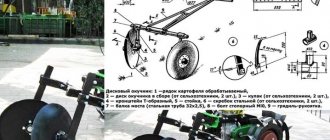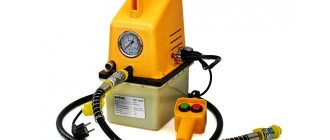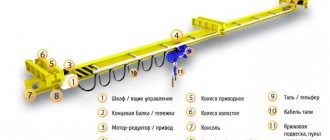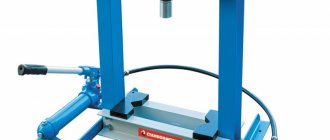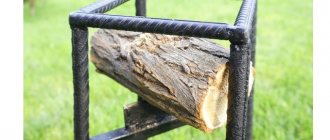How to make homemade hydraulics for a tractor
Farmers are interested in what hydraulics are for a homemade tractor, and how to make it with their own hands. Small dimensions are not a hindrance to performing the necessary tasks and proper operation of all functions. This is proven by such agricultural equipment as mini-tractors - perhaps the most popular equipment used by farmers when cultivating lands of different sizes and with varying soil complexity.
Is it possible to make hydraulics for a mini-tractor yourself?
A mini-tractor allows its owner to plow the soil, cultivate the soil, and also transport cargo, including harvested crops, coal or firewood over fairly long distances. It is worth noting that due to the large number of functions, mini-tractors can be used not only for agricultural work, but also in construction and public utilities.
Thanks to its widespread use, there are ways to independently design equipment. This raises a number of questions regarding the manufacture of certain elements, including the hydraulic system that allows the tractor to work with attachments such as a trailer. Many farmers who decide to make a tractor with their own hands are wondering how to make hydraulics for a homemade tractor.
Installed hydraulics on a homemade mini tractor makes working on it more convenient. Attachments are, of course, an important element of the tractor design, but the hydraulic system is a much more important system on which the functioning of all equipment depends. It can greatly reduce labor costs when operating the machine, and also make the tasks of agricultural work easier. The system provides such capabilities thanks to a large number of attachments installed on the tractor.
- The tractor's hydraulic linkage system makes steering much easier.
- Hydraulics for a mini tractor work to simplify wheel control when installed near the drive wheels.
- The design of the hydraulic system for the tractor allows you to turn the tractor while remaining almost in one place.
- Hydraulics on a homemade mini tractor, if a special brake is installed, allows you to quickly stop the machine.
Before you decide that you need to connect a hydraulic cylinder, you should take into account that the main power of the power plant will support the operation of these very elements, which is why the mini-tractor will not be able to reach the maximum possible speed. This is especially true for a homemade tractor, whose power, as a rule, is not very high.
What does the hydraulic system of a mini-tractor consist of?
Before you begin work on creating and installing a tractor hydraulic system, you need to understand what components it includes.
A hydraulic drive is necessary if the minitraktor will be used together with attachments.
Hydraulics consists of the following components:
- Pump with activation mechanism
- Oil tank
- Pipeline
- Filter
- Distributor
- Hydraulic cylinder
All these components and parts can be purchased separately or as a set; the main thing is to choose a pump that matches the power of the power unit and is suitable for solving specific problems.
How to make a hydraulic system for a mini-tractor with your own hands
Farmers who decide to make their own agricultural machinery are interested in how to make hydraulics for a mini tractor. This issue is also due to the significant high cost of ready-made equipment offered on the market. The popularity of such a homemade product is also due to the fact that all the parts necessary to assemble the tractor’s hydraulic system are available to everyone. Also, the system diagram is published on the Internet in the public domain, which also makes the production of equipment much easier.
Do-it-yourself hydraulics for a mini tractor gives the farmer three main advantages:
- Additional equipment can be used, including a trailer.
- Better braking system.
- The most convenient control.
- All elements are regulated taking into account the needs of a specific person, who will subsequently drive the tractor and supervise all work. This is what will make the tractor the most comfortable to drive.
Let's look at how to make hydraulics for a mini tractor with your own hands. A device such as hydraulics for a mini tractor requires drawing up a competent diagram and preparing all the necessary elements for assembly. One of the key elements is a powerful oil pump, which will act on the hydraulic system of the mini tractor.
All elements are mounted on a frame made of metal, and the condition must be met that all elements are attached as close to the axis as possible.
In addition, you need to prepare in advance a distribution element that will help change the direction of rotation, several hoses, a tank and a special element for removing oil.
- The hydraulic pump must be located above the tank so that it has free access to the oil supply and ensures quick start-up of the system.
- It is imperative to calculate the operating power of all elements of the equipment, so you can understand whether it is worth installing a hydraulic pump equipped with two sections. This will make work uninterrupted, even if the loads are very heavy.
- Cleaning oil filters will keep your hydraulic attachment system running longer.
DIY hydraulics for a mini tractor
The question “How to make hydraulics for a mini tractor with your own hands?” occurs among many owners of agricultural machinery. After all, factory equipment is quite expensive. Another reason to think about homemade products was the availability of information and parts for assembling each individual unit.
By creating a manually controlled hydraulic valve yourself, owners of special equipment will receive several advantages:
- possibility of using additional attachments;
- improvement of the braking system;
- simplified control of the unit.
The adjustment of all components and parts is carried out for a specific person, who will manage the work process. And this will make the tractor more convenient and comfortable to operate.
To assemble hydraulics yourself, you will need a competent diagram and a number of spare parts. First of all, you need a good oil pump that will act on the hydraulic motors. The hydraulic elements are mounted on the metal frame of the mini-tractor, as close as possible to the drive axle. You will also need a distribution element to change the direction of rotation, a set of hoses, a reservoir and a spool for oil drainage. When assembling, you should consider several nuances:
- the hydraulic pump for the minitractor is located directly above the tank (free oil supply, quick start);
- it is necessary to calculate the power of all tractor mechanisms (perhaps for greater productivity you will need a two-section hydraulic pump, which guarantees uninterrupted operation of the mechanism even under significant loads);
- The installation of cleaning oil filters will extend the service life of the system.
After purchasing the necessary parts and careful calculations, you can begin assembling the unit, calibrating the parts and checking the tightness of the connections, the cleanliness of the hoses, and the functioning of the hydraulics.
How a homemade hydraulic system works
Let's look at how hydraulics work on a mini tractor. Manufacturers of diesel mini tractors answer the question of what kind of oil to pour into the hydraulics very simply: the simplest oil is M-8DM or M-8 V. However, in winter it needs to be changed to a more viscous substance.
Many people are interested in the problem of excess pressure on the structure. Therefore, in order to regulate it, some craftsmen install a distributor that operates on two pistons - it distributes the pressure in the required way. A self-made unit, like hydraulics, requires the installation of some ready-made parts, including a distributor. It can be removed from MTZ.
Once the system is connected, it is easy to start. With the unit running, the equipment will need to be run in to check that everything is working correctly and without failures. On a machine with a homemade hydraulic system, you need to check the oil pressure in the engine and the serviceability of all components, and then check the tractor in operation.
How to make hydraulics for a mini-tractor with your own hands?
Hydraulics is a technical system that operates through the influence of fluid pressure on other elements of the system. During the impact process, kinetic energy is generated, which is converted into mechanical energy, as a result of which the useful work of a particular mechanism is performed. Various agricultural units, such as mini-tractors, are equipped with a hydraulic system. It is used to control various attachments.
This system is present in the design of any tractor produced by the manufacturer. It can be modified and optimized to suit your needs. A homemade mini-tractor must be equipped with hydraulics, which will allow you to use the equipment with maximum efficiency.
Necessary tools
Each specific case may require its own set of tools and materials required for assembly. Their main set:
- welding machine;
- Bulgarian;
- drill;
- drill;
- taps for thread cutting;
- set of wrenches.
The list can be supplemented with items depending on the assembly conditions.
Required parts:
- hydraulic pump;
- hydraulic distributor;
- hydraulic tank;
- transmission belt;
- hoses and their fastenings;
- hydraulic cylinders;
- bolts and nuts;
- clamps;
- oil filter;
- various fasteners, the name of which is determined by each specific case.
The main components are shown in the photo.
How to do it?
Work on creating your own hydraulic system for a mini-tractor begins with designing a future design and carrying out calculations aimed at optimizing the ratio of expended resources and efficiency. The power of the tractor must correspond to its intended purpose, and the technical characteristics of the hydraulic system components are proportional to the loads applied to them.
Insufficient power of the oil pump or low load capacity on the hydraulic cylinders can lead to rapid failure of the entire system or individual components. An overestimated level of these indicators will increase the consumption of fuel and other resources and create an imbalance in the system. To compensate for the difference in technical characteristics and equalize the balance, additional items are installed: a second pump, a hydraulic cylinder, and others.
The drawing must reflect the design of the supporting frame, which will include space for the pump, distributor, pistons and other additional elements, as well as a hydraulic circuit connection diagram. At the same time, its configuration must be optimized in such a way that the distance from the engine output shaft to the nearest hydraulic system force transmission point is minimal.
The pump is installed as close as possible to the drive shaft. The reservoir with working oil is located above it, which ensures a free supply of liquid to the pump blades and reduces the leakage rate of useful mechanical energy. A filter is installed between the liquid reservoir and the pump. Its presence prolongs the uninterrupted operation of the entire system.
By means of reinforced hoses, the pump is connected to a hydraulic distributor, which is equipped with control elements. There may be several of them depending on the functionality of the hydraulics. Since in order to maintain pressure in the system, oil must continuously circulate through it, the distributor regulates the direction of its movement and supply to the cylinders, and also cuts off the flow during idle operation. The distributor controls are special levers supplied by the manufacturer with it.
After mounting the distributor, hydraulic cylinders are installed on the working part of the frame. These elements can be represented by special piston blocks designed for use in a hydraulic system. In other cases, they can be made independently from oil-type automobile shock absorbers.
Attachments are installed on the tractor in conjunction with hydraulic cylinders - moving parts of the system that transmit mechanical force to it. The design of fastening mechanisms is determined by the type of equipment, its actual configuration and the nature of the target work performed with its help.
The assembled hydraulic system must be equipped with technical components and insulation means that require their mandatory installation. Among them are:
- drain unit in the hydraulic tank;
- pressure relief valve in the tank;
- pressure meter;
- shut-off valve;
- draining the pump and hydraulic distributor;
- fine filter elements at the inlet to hydraulic cylinders;
- O-rings, washers, gaskets, nuts, clamps.
Before starting work, the entire system is configured.
The working diagram of hydraulic equipment for a mini-tractor is shown in the diagram:
Design features
Hydraulics on a mini-tractor work on the same principle as all other similar systems. It contains a hydraulic pump that builds up pressure in the system and forces fluid to move through it. It is connected to a source of filler, which is an expansion tank. This unit is driven by transmitting torque from a diesel engine through a belt or mechanical connection to a shaft or transmission.
Although the system is called hydraulic, it is filled with oil. It has a lower boiling point, a suitable expansion coefficient and serves as a lubricant for the moving parts of the mechanism.
Flexible hoses with reinforced walls are used to transfer fluid through the system. All their connections are sealed and reinforced. Through them, under the influence of pressure, the oil enters the hydraulic distributor with a floating position, and then into the hydraulic cylinders, which act as pistons. The pistons perform mechanical work, which drives the corresponding attachments.
Instructions for controlling the hydraulics of a mini-tractor
The system is controlled using a lever(s) in conjunction with a hydraulic distributor. Its (their) main function is to change the positions of the distributor control valves, supply pressure to the desired section, and disconnect the fluid circulation circuit from the final units of the unit.
A simple hydraulic system has three control lever positions:
- neutral - oil circulates separately from the pistons;
- expansion of the piston - pressure forces it to take the most extended position;
- movement of the piston - the pressure is released, the vacuum created by the escaping liquid pulls it along with it, returning it to its original position.
At the moment the piston(s) move, the attachment performs the work intended for the purpose of its production.
Any hydraulic system is equipped with mechanisms for starting and stopping the hydraulic pump, fixing positions and emergency (manual) control.
Prevention
To ensure efficient operation of the tractor hydraulic system, it is necessary to follow the rules of operation and timely maintenance.
When working with equipment equipped with hydraulics, its components should be regularly checked for malfunctions. The occurrence of a small-scale failure inevitably leads to failure of other parts of the system. If one is detected, you must immediately use all available means to eliminate it:
- do not allow the required load on the hydraulic pump, hydraulic cylinders, oil hoses and other components to be exceeded;
- avoid excessively high pressure, if necessary, release it in a timely manner or select a suitable control valve;
- To maintain stable operation of the hydraulic mechanism, it is important to change/add fluid to the system in a timely manner: insufficient quantity will lead to a decrease in operating efficiency and rapid failure of the unit;
- All maintenance and repair work on the system should be carried out with the tractor engine turned off (cold) after releasing the pressure.
Table of common hydraulic system faults and how to fix them:
Malfunctions and their causes
Remedy
Malfunction: low lifting and pushing force of hydraulic cylinders or its complete absence.
Reason: the oil level in the system has dropped.
An oil with unsuitable characteristics was used.
Replace the oil with a suitable one.
The oil or hydraulic cylinder filter is dirty.
Replace or wash the filter element.
Presence of air in the system.
Blow out the system - remove air, identify the point of its penetration and eliminate it.
Presence of fluid leakage through worn seals.
Replace the seals with new ones.
The operation of the pressure relief valve is disrupted - it gets stuck in the open position.
Wash/blow out the valve. Replace if necessary.
Malfunction in the valves of the hydraulic distributor.
Hydraulic drive, the simplest
The simplest hydraulic drive consists of an engine, a pump and distributor and a hydraulic drive (hydraulic motor or hydraulic cylinder)
Hydraulic tank
On the drain line after the hydraulic distributor and before the hydraulic pump, it is necessary to install an expansion tank and filters; I used a hydraulic tank from ZIL.
It already has a built-in filter, but you may want to install an additional filter for finer cleaning.
Hydraulic pump
Engine
Engine
It's best to use it as powerfully as possible.
From experience I can say that 13 hp. It is enough for the drive with pump
to work fully, but until the system warms up the engine sometimes stalls under load, after warming up this does not happen. It is still better to use a diesel engine, although a gasoline engine also copes with its task. And it is better to use an engine with a larger power reserve. You can even use a used Lada engine. the engine can be bought for 5,000 rubles, but this is if you need a powerful hydraulic power station.
Hydraulic cylinders
Hydraulic cylinders
you can look for a used one. on Avito or disassembly. New ones in the store sell for about 6,000 rubles, you can find them cheaper, sometimes I came across hydraulic cylinders for lifting the cab for 3,000 rubles.
Hydraulic distributor
The simplest hydraulic valve
without fixation, it will cost from 3000 - 4000 rubles, but it is better to buy at once with a large number of sections, so that in the future you can expand the functions of your hydraulic drive by connecting additional operations.
Moreover, a 3-section hydraulic distributor will cost only about 8,000 rubles.
I always count the number of operations I need and try to buy one more section, and very often it turns out that it’s not in vain; as work progresses, there is always a desire to add some function.
High pressure hoses (HHP) and fittings
All components must be connected to each other using high-pressure hoses (HPS), any workshop will help you repair the HPS, just bring them the kit that needs to be connected and tell them the sizes of the hoses, they will select the fittings themselves. Inch thread, metric thread, you won’t have to figure it out if you turn to professionals.
How to make hydraulics on a walk-behind tractor with your own hands - we describe in detail
Making a device such as hydraulics for a mini tractor with your own hands is a good solution for saving money and getting more performance from the device. Mounting and creating a new system is not something particularly difficult, and for those who like to do something with their own hands, this will be a great opportunity to get creative and make their own version of hydraulics.
hydraulics for walk-behind tractor
We install hydraulics on a walk-behind tractor,
Pavel Vadimovich Vorobyov
Maladets. Actually, no mockery. What kind of pump, valve?? In short, details, details. And he. And she. And he.
Pavel Vadimovich Vorobyov
Required topic. Preferably a photo of the pendant.
Maladets. Actually, no mockery. What kind of pump, valve?? In short, details, details. And he. And she. And he.
pump NSh-10 and distributor from tractor T -16.25, something like that)
Required topic. Preferably a photo of the pendant.
NSh-10 tank KRAZ with power steering.
I decided to play with the wheels, so I started cutting off the bolts when the load was applied. Well, compared to the stock ones *Fire*
I decided to play with the wheels, I started cutting the bolts when the load
it's time to make a real mini tractor
Tractor T2 I'm not lazy, I'm energy-saving. In Siberia, only dogs eat dumplings without vodka.
Good afternoon, dear forum members. I would like to install a hydraulic system but I don’t know anything about it. Tell me what equipment is needed to install a hydraulic system. One hydraulic pump must be installed.
Good afternoon, dear forum members. I would like to install a hydraulic system but I don’t know anything about it. Tell me what equipment is needed to install a hydraulic system. One hydraulic pump must be installed.
— the pump itself (NSH-10, or better yet with power steering ZIL, or even better with power steering UAZ). — hydraulic tank with filter. - hydraulic distributor (depending on the purpose, if a floating mode is required, then the R-80, if without a floating one, then now there are many “foreign” ones at an affordable price. Open the manual for any Soviet tractor and study the section on the hydraulic system - everything is described there simply and clearly.
Tractor T2 I'm not lazy, I'm energy-saving. In Siberia, only dogs eat dumplings without vodka.
Advantages of the device
First, let's consider what benefits the created creation will bring. Creating a mini tractor with your own hands is not so difficult, because all the parts can be purchased separately, and tanks, distributors, pumps, engines and other components of the machine can be freely borrowed from other devices.
For farmers, homemade tractors are not uncommon; this simple unit can be used to perform many useful tasks: plowing the land, mowing and collecting grass, dragging large loads and many others. With such a big benefit from the device, you can still save money on its purchase.
- Possibility to add additional attachments. When developing an independent circuit, the hydraulics for a walk-behind tractor may differ from the typical one and be supplemented with other devices (sensors, hydraulic pump, pistons, etc.).
- Improved control. During creation, the parts are precisely adjusted to suit the person. This will make working on the tractor more enjoyable and comfortable.
The only drawback is the time required to create and connect parts of the structure.
Hydraulics for a DIY mini-tractor
If you decide to make a mini-tractor yourself, then without a hydraulic system such a design will not be considered a full-fledged agricultural machine. You can assemble the hydraulic unit yourself. The necessary elements can be removed from any old equipment.
The heart of any hydraulic system is the pump. This device ensures the movement of fluid throughout the system. Hydraulic fluid enters the pump from the oil tank. The pump itself is driven by a diesel engine, which is equipped with a mini-tractor. NSh-10 can be used as a pump. The oil, pushed by the pump, enters the hydraulic distributor through flexible hoses.
It is unlikely that you will be able to assemble this complex assembly with your own hands, so you need to remove the distributor from any broken tractor. The best option would be to use the R-80. These hydraulic valves are installed on MTZ tractors.
After the distributor, the oil enters the hydraulic cylinder, which is responsible for raising and lowering the attachment. The finished structure is installed on the frame of a mini-tractor as close as possible to the drive axle.
You can supplement the design with hydraulic motors that are connected to the wheels. This scheme has certain advantages and is essentially a universal braking system.
When oil enters the hydraulic cylinder, its level in the system drops and the wheels slow down. If you move the hydraulic control levers to the neutral position, the drive wheels are completely locked.
DIY hydraulics for a mini tractor
The question “How to make hydraulics for a mini tractor with your own hands?” occurs among many owners of agricultural machinery. After all, factory equipment is quite expensive. Another reason to think about homemade products was the availability of information and parts for assembling each individual unit.
By creating a manually controlled hydraulic valve yourself, owners of special equipment will receive several advantages:
- possibility of using additional attachments;
- improvement of the braking system;
- simplified control of the unit.
The adjustment of all components and parts is carried out for a specific person, who will manage the work process. And this will make the tractor more convenient and comfortable to operate.
To assemble hydraulics yourself, you will need a competent diagram and a number of spare parts. First of all, you need a good oil pump that will act on the hydraulic motors. The hydraulic elements are mounted on the metal frame of the mini-tractor, as close as possible to the drive axle. You will also need a distribution element to change the direction of rotation, a set of hoses, a reservoir and a spool for oil drainage. When assembling, you should consider several nuances:
- the hydraulic pump for the minitractor is located directly above the tank (free oil supply, quick start);
- it is necessary to calculate the power of all tractor mechanisms (perhaps for greater productivity you will need a two-section hydraulic pump, which guarantees uninterrupted operation of the mechanism even under significant loads);
- The installation of cleaning oil filters will extend the service life of the system.
After purchasing the necessary parts and careful calculations, you can begin assembling the unit, calibrating the parts and checking the tightness of the connections, the cleanliness of the hoses, and the functioning of the hydraulics.
Beginning of work
In order to create any device, they first think through or borrow its diagram. Depending on this, parts are purchased. Some craftsmen create homemade hydraulic distributors for mini tractors, which significantly saves money.
But not everyone will be able to assemble a high-quality and functioning structure. In some cases, it is better to purchase an element in a store or borrow it from other agricultural equipment.
The sequence of work will be as follows:
- creating a hydraulic diagram;
- purchasing the necessary parts;
- installation and connection of hydraulics;
- calibration of parts;
- checking the functioning of hydraulics with the transmission.
Hydraulics for a mini tractor from a walk-behind tractor necessarily includes the following components:
- hydraulic tank with oil;
- engine;
- hydraulic pump;
- hydraulic distributor;
- hydraulic motors and pistons;
- connecting hoses.
As an addition, filters for minitractor hydraulics, pressure meters and other auxiliary elements are installed.
This is done to protect the pump and motor from contamination by debris. When drawing up a diagram, consider the following data:
- The hydraulic pump must be located under the tank so that oil flows to it freely (under the influence of gravity). This is required so that there are no problems during startup.
- In order for the mechanism to work without interruption and last a long time, it is necessary to calculate the required power of all devices in the machine. Based on these data, a hydraulic pump is purchased. If its power is not enough, then an additional auxiliary pump is installed, which will be switched on separately at high load.
- In order for the mechanism to function for a long time, pressure measurement sensors and filters for oil purification are installed in it.
For the oil in the system to perform its function, it must be constantly in motion.
This is carried out by a hydraulic pump, which only performs the function of moving the volume of liquid through the system. The engine transmits torque to the pump and thereby forces it to pump liquid. It connects to the distributor. Depending on the position of the lever, the oil is returned through some tubes back to the tank or through others it is sent to the hydraulic motor or pistons. Hydraulics are installed on a mini tractor from a walk-behind tractor quite simply and, thanks to the high density of the oil, are capable of performing heavy traction operations.
Any option can be used as an engine for mini tractors: electric, diesel or gasoline. The main condition: it must have a sufficient number of revolutions to ensure the functioning of the hydraulic pump.
The most common solution is a water-cooled four-cylinder diesel engine. And for simple tasks, such as mowing or harvesting grass, you can use a walk-behind tractor. You can even move the tractor using a hydraulic pump.
For smooth control of the drive wheels, hydraulics are also connected to the steering wheel. The scheme can be created independently. But in order not to bother yourself with thinking through the nuances, it is better to borrow a ready-made drawing and make the desired adjustments there.
The hydraulic system of tractors is responsible for: braking, the functioning of the pistons and the steering mechanism. If hydraulic motors are used, then also for movement.
This method of driving is slow, but allows for large traction work, for which it is valued by farmers.
How to install
When all the components have been purchased, all that remains is to assemble the minitractor, in the process connecting all the elements. To do this, the engine must be connected to a purchased hydraulic pump. Further from it, the tubes are connected to the distributor, after which directly to equipment in the form of pistons, motors, as well as a hydraulic tank connected to the pump. In this case, it is necessary to install filters between the tank and the pump, which are necessary to clean the oil.
Upon completion of installation, all systems must be checked. If problems are identified in operation, all hoses are examined for integrity, as well as tightness of connections. When everything is good, the unit is tested during a test drive. At this time, correction is made to the functioning of the steering hydraulics, as well as movement, if there are deviations. The floating steering system should be eliminated.
Hydraulic design of a mini tractor
Homemade hydraulics are a good way to expand the functionality of a mini tractor and save a significant amount. The assembly and installation of such a structure cannot be called something very complicated. If you have the necessary parts and tools, every farmer who wants to can make this mechanism.
The main element of any hydraulic system is the pump, which is responsible for circulating fluid through the hoses. Oil flows to the pump from the reservoir. The pumping mechanism itself operates from the energy generated by the diesel engine of the mini tractor. Under the action of the pump, the oil flows through flexible tubes to the distributor. To make hydraulics for an agricultural machine, you can use an NSh-10 pump.
Making a hydraulic distributor with your own hands is quite difficult, so the best solution would be to dismantle a ready-made unit from any old tractor. A distributor of the P-80 brand, which is equipped with MTZ tractors, will be suitable for installation on a homemade machine.
Through the distributor, the oil enters the cylinder, the main function of which is to raise and lower attachments. Ready-made homemade hydraulics should be installed on the frame of a homemade machine, closer to its drive axle.
How to install hydraulics on a mini tractor?
Hydraulics are installed on a mini tractor in order to move the unit and maintain the operation of the pistons. To eliminate possible complications when plowing the soil, it is necessary to use hydraulic motors. After all the parts for the job have been purchased, you can connect the hydraulics to the mini tractor.
This procedure is performed in this order:
- The first step is to install the hydraulic distributors. A separate lever must be allocated for each group of pistons. In most cases, 2-3 levers are enough, the first of which is necessary for braking, the second for controlling the power frame, and the third for starting the hydraulic motors. For excavators and other mini tractors with buckets, hydraulic valves with extended functionality should be used. Their prices are much higher than conventional mechanisms;
- The hydraulic pump must be selected taking into account several important characteristics. The first of them is the pressure that is necessary to start the hydraulic motor. If the pressure is too low, the engine will not start. The second important characteristic is the volume of pumped oil. The more oil the pump pumps per minute of operation, the higher the speed of the hydraulic motors and pistons will be. The selected pump should be installed under the oil tank;
- After this, a hydraulic pump must be connected to the standard engine of the minitractor, the tubes from which must be connected to the distributor. Oil pipes should be routed from it to the motors and pistons, as well as the hydraulic tank;
- The filter element will need to be installed between the hydraulic tank and the pump. The video will tell you more about connecting the elements of the hydraulic system.
As soon as the installation of hydraulics on the mini tractor is completed, you will need to check the operation of the assembled structure. If a sufficiently high pressure is not created inside the system, then you need to make sure that the tubes and hoses are tight. After this, you can begin testing the hydraulics directly while driving the mini tractor.
Assembling hydraulics with your own hands - what are the advantages of making them?
Among modern farmers, homemade mini tractors are far from uncommon. The agricultural machine is capable of performing many jobs: plowing the land, mowing and collecting grass, as well as towing heavy large luggage using a mini tractor trailer. The list of these procedures can be significantly expanded, but this requires hydraulics for a homemade mini tractor.
Assembling this mechanism manually provides a number of advantages:
- the farmer can always add additional devices. Having independently developed a diagram of the hydraulic system, the owner of a homemade machine receives unlimited possibilities for equipping the mechanism with various additional devices: pistons, sensors, hydraulic pumps;
- improved control of a mini tractor - during the process of assembling and installing hydraulics, the farmer will be able to adjust all its elements “to suit himself.” This will make control of the mini tractor more precise, and the work itself much more convenient and enjoyable.
The only significant disadvantage will be the need to spend your time on assembly. However, these losses are more than compensated for during the further operation of the improved mini tractor.
How to make hydraulics for a mini tractor with your own hands?
To make a specific device, you will need a detailed diagram. The list of elements necessary for assembling the structure depends on it.
To avoid mistakes, you should familiarize yourself with the plan for the upcoming work. Hydraulics for a mini tractor are assembled in several stages.
Their list includes:
- preparation and study of drawings;
- purchasing the parts necessary for assembly;
- installation and connection of the hydraulic system;
- adjustment of elements;
- testing the interaction of the mechanism with the transmission.
To make a homemade system you will need the following parts:
- hydraulic tank and oil;
- hydraulic pump;
- hydraulic motors and pistons;
- engine;
- hydraulic distributor;
- connecting tubes.
In the process of selecting a circuit for assembly, you will need to take into account certain rules.
Their list includes:
- The hydraulic oil pump must be installed under the reservoir. In this case, oil will flow from the tank to the pump under the influence of gravity. This will prevent any problems from occurring when starting the hydraulics;
- In order for the future design to work for a long time and without failures, it is necessary to calculate the exact power of all machine mechanisms. Taking into account the data obtained, it is necessary to select a hydraulic pump. If its maximum power is not enough, you will need to install an additional pump. It will turn on separately if the performance of the main device for swapping is insufficient;
- To extend the service life of hydraulics, it must be equipped with filters to clean the circulating oil, as well as pressure gauges to control pressure.
To maintain stable operation of the system, oil must continuously circulate through its hoses. A hydraulic pump is responsible for this, which moves the liquid through the hydraulic design. The pump receives the energy required for operation from the minitractor engine. To do this, the motor must be connected to a hydraulic distributor.
The direction of oil movement is regulated by a special lever, which can be in two positions. In one of them, oil flows into a reservoir, and in the other, it is directed from the reservoir to pistons or a hydraulic motor. The oil inside the system has a high density, due to which it is capable of performing quite heavy traction actions.
The hydraulic system for a homemade mini tractor can receive energy from any engine: gasoline, diesel or electric. In this case, the main thing is that the motor can spin the shaft to the required number of revolutions. Only in this way will it ensure the operation of the hydraulic pump.
Most often, farmers use 4-cylinder diesel engines equipped with liquid cooling systems. If a mini tractor with hydraulics is used to perform simple tasks, then it can be equipped with a less powerful diesel or electric motor.
Hydraulics are also necessary for smooth steering of a mini tractor. In this case, you will need to prepare a separate drawing. He will tell you the correct installation and fit of parts into the overall design.
It should be remembered that when using hydraulics, the speed of movement of the mini tractor will be significantly lower. This is due to the fact that during this operating time its engine will transfer part of its energy to the hydraulic motor. The other part will be transmitted directly to the drive axle of the unit.
What are the advantages of hydraulic drive technology?
Most modern mini tractors are quite rightly equipped with hydraulic systems. Unlike equipment that does not include hydraulics, they have a number of advantages:
- ease of operation - an agricultural machine with a hydraulic drive is capable of turning almost in one place, which allows it to be more efficient when performing a number of jobs - mowing grass or plowing the soil;
- the ability to aggregate different mounted implements - for mini tractors with hydraulics you can use a mower, seeder, milling cutter, harrow, trailer for a mini tractor and a number of other implements;
- improved braking system - hydraulics on the mini tractor make it possible to brake the unit by reducing the amount of oil supplied. If the handles that control the load distribution are placed in the neutral position, the wheels of the minitractor will be completely blocked. This method is intended for emergency braking and can be used instead of the parking brake;
- The hydraulics on a mini tractor have a fairly high strength, thanks to which they are able to withstand heavy loads without increasing the pressure on the agricultural machine.
Thanks to all these advantages, mini tractors with hydraulics have been able to occupy an important place in the lives of farmers. Moreover, today such agricultural machines are actively used not only in the agricultural sector, but also in the construction of buildings and roads, the logging industry, and also in warehouses.


